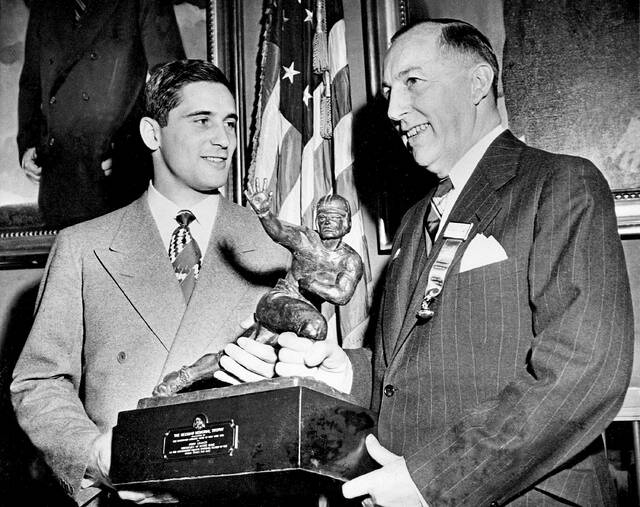Connellsville native Johnny Lujack, 1947 Heisman winner who led Notre Dame to 3 national titles, dies at the age of 98
Connellsville native Johnny Lujack, the Heisman Trophy-winning quarterback who led Notre Dame to three national championships in the 1940s, died Tuesday in Florida following a brief illness. He was 98.
Lujack’s death was confirmed by his granddaughter, Amy Schiller, who said he had entered hospice care recently after having been in good health until a couple of weeks ago.
“He was not only a legend in Notre Dame football and the sports world,” Schiller said, “he was a legend as a father and grandfather and great-grandfather.”
Lujack is considered one of the greatest Notre Dame players of all time, having won the Heisman in 1947 and leading the Irish to national titles in 1943, 1946 and 1947.
Lujack posted a 20-1-1 record as the starting quarterback for coach Frank Leahy. He played for the Irish in 1942 and ’43, served two years in the Navy during World War II and returned to Notre Dame for the 1946 and ’47 seasons.
He was a four-sport athlete at Connellsville High School from 1939-41, also competing in baseball, basketball and track and field. He also was the senior class president and valedictorian. In 2009, he donated $50,000 toward construction of a weight room at Falcon Stadium, and it was dedicated the Johnny Lujack Training Facility just days before he was inducted into the Fayette County Sports Hall of Fame alongside late Olympian John Woodruff, also of Connellsville.
“Any time you get honored by the county where you started your football career, it’s something very special,” Lujack told the Tribune-Review after his induction. “These are things you don’t forget, because they are your closest friends from many, many years ago. It’s great to be back.”
Lujack was pushed toward attending and playing at the U.S. Military Academy (Army) by many in Connellsville but, being a fan of Notre Dame football growing up, he instead chose to join the Fighting Irish, where he also was the starting guard on the basketball team, played baseball and ran track.
He was the Associated Press athlete of the year in 1947, when he was a first-round draft pick of the Chicago Bears. Joe DiMaggio was the runner-up. He played four seasons for the Bears, leading the team in scoring each year before retiring at 26.
While Lujack had plenty of offensive highlights at Notre Dame, he is best remembered for a play he made as a defensive back in an era when players stayed on the field for nearly every play.
A standing-room-only crowd of about 75,000 packed Yankee Stadium in 1946 to see No. 1 Army — the two-time defending national champions — face then-rival Notre Dame, which was ranked No. 2. Lujack made the game-saving tackle against Doc Blanchard in a 0-0 tie. That contest is frequently referred to as the game of the century.
Lujack, in a 1996 interview with the AP, said that was the game he was asked about most often. He downplayed the tackle of Blanchard, who won the Heisman in 1945.
“You were back there,” Lujack said. “You were supposed to make the tackle.”
Lujack finished third in Heisman voting in 1946 before he won the award as the college game’s outstanding player the next year, when he completed 61 of 109 passes for 777 yards with nine touchdowns in leading the Irish to a 9-0 record and their second consecutive title.
He took over as the starting quarterback for the top-ranked Irish in 1943, after Angelo Bertelli left after six games to join the Marines. Among the other Irish greats he played with were Creighton Miller, Terry Brennan, Emil Sitko, George Connor, Bill Fischer and 1949 Heisman winner Leon Hart.
“We always felt that a game was kind of an easy scrimmage because the scrimmages we had against each other were mean and rough,” Lujack once said.
Lujack intercepted eight passes as a rookie with the Bears, and in 1949 he threw for 468 yards and six touchdowns in a 52-21 win over the Chicago Cardinals. He played in the Pro Bowl his final two seasons before retiring.
He served as an assistant coach at Notre Dame in Leahy’s final two seasons. He then moved to Davenport, Iowa, where he owned an auto dealership until 1988.
Remove the ads from your TribLIVE reading experience but still support the journalists who create the content with TribLIVE Ad-Free.




